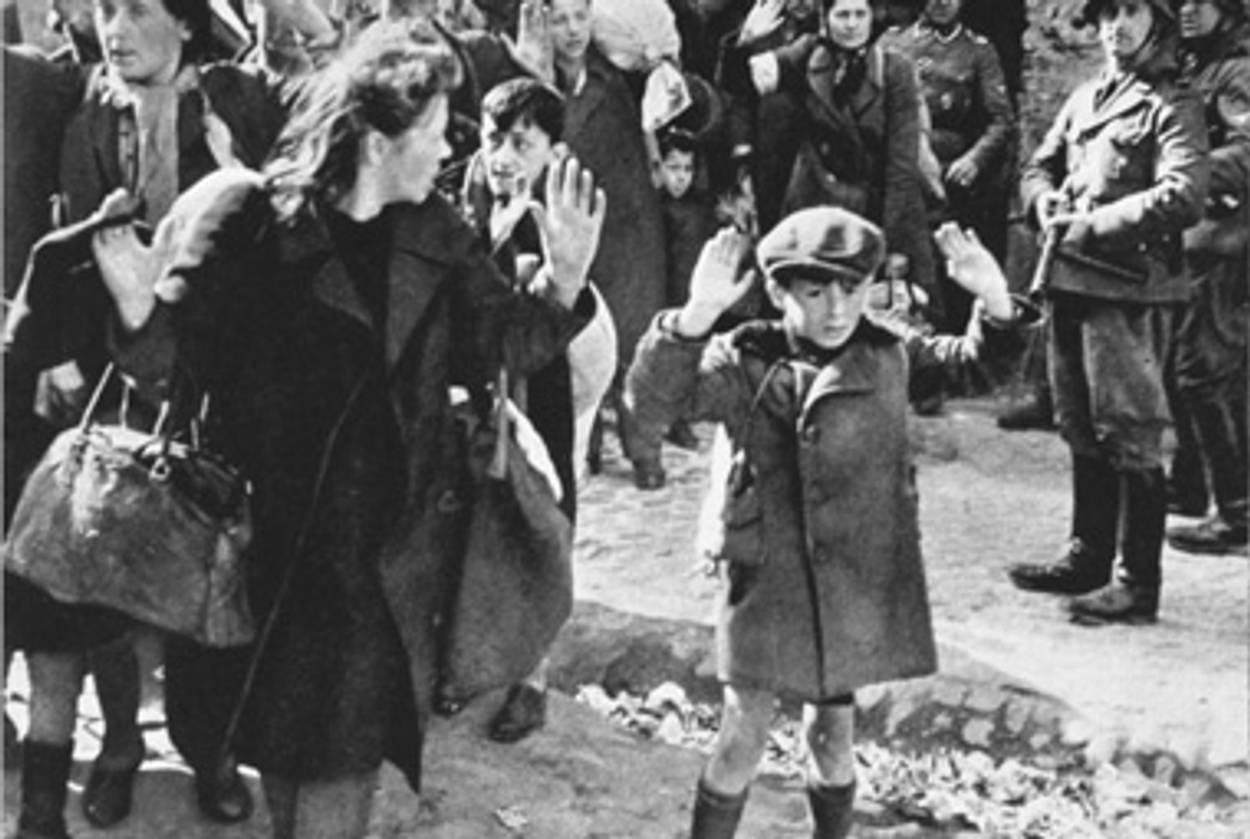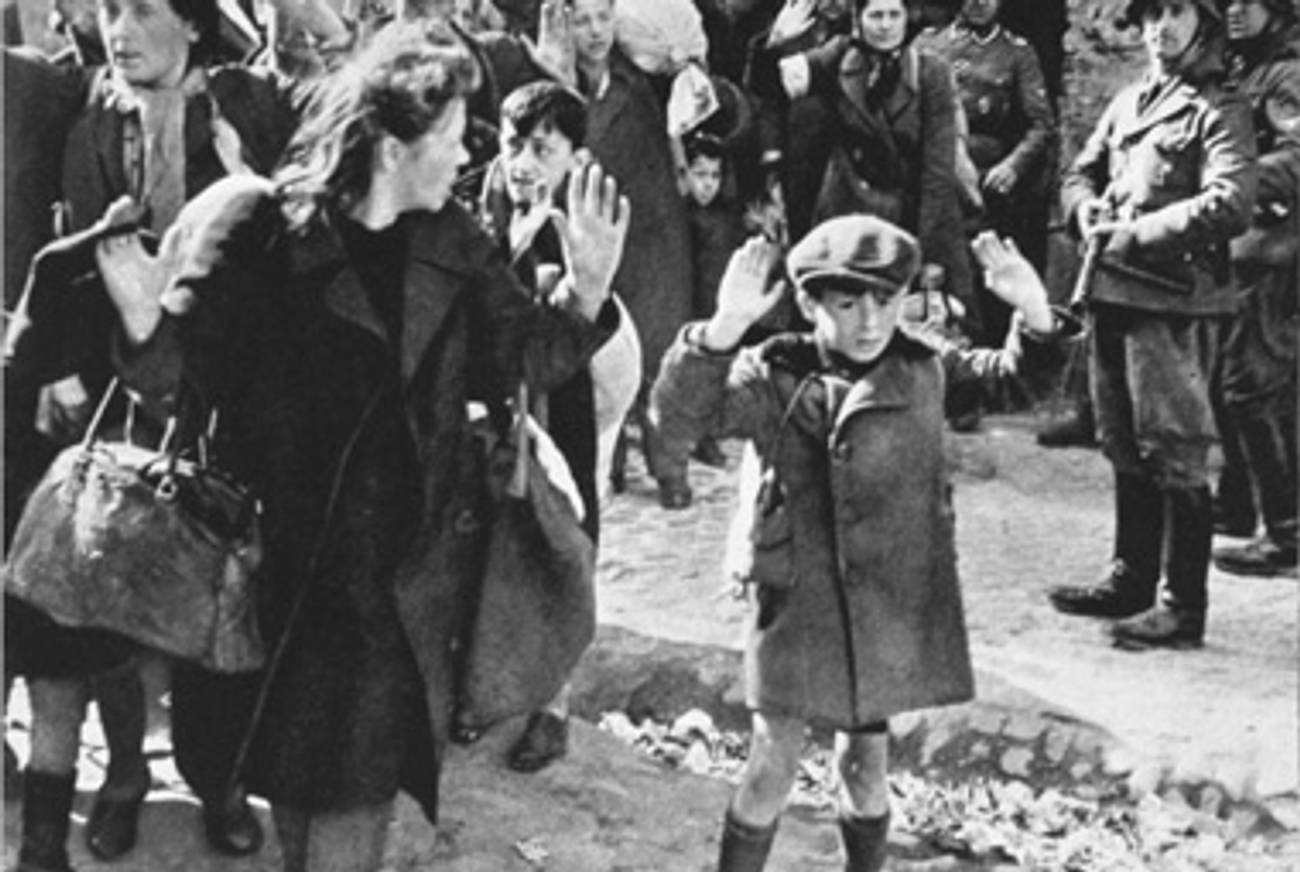Caught on Film
An Israeli historian uses an iconic photograph to tell five intertwined stories of the Warsaw Ghetto




The most devastating book I have ever read—though read might not, in this case, be the right word—is French Children of the Holocaust: A Memorial. This nearly 2,000-page volume, edited by the French Nazi-hunter Serge Klarsfeld, lists each of the 11,400 French Jewish children deported to Auschwitz during the Second World War, documenting their name, birthplace, age, and the date of the transport in which they left France. These facts are brought terribly to life by the book’s 2,500 photographs, in which the faces of many of the children—some of them just toddlers—are preserved.
What the book leaves behind, in addition to grief and fear, is a powerful sense that the killers of these children can never be understood. Perhaps one could imagine the process by which a German soldier or French policeman grew to hate Jews enough to want to kill them. Such men had been told for years that the Jews were their mortal enemies, that solving the Jewish problem would mean the salvation of their own people. This kind of hatred, based on fear and leading to preemptive violence, is too common, all over the world, to be totally unbelievable. But to point a machine gun at a 5- or 6-year-old boy, who has his hands in the air and a look of panicked misery on his face—what could the perpetrator of such an act be thinking?
That is the question Dan Porat tries to answer in The Boy: A Holocaust Story (Hill and Wang, $26). The boy in question can be seen in one of the most famous images of the Holocaust, a photo of Jews being rounded up during the destruction of the Warsaw Ghetto in 1943. Porat, a professor at Hebrew University, became obsessed with this photograph and the questions it raised: “Did the little boy … survive the Holocaust? What was his story? …The SS man with a machine gun, who was he? How could he make a little boy raise his hands like this? Who took the photograph? What brought them there?”
These were the questions that inspired The Boy, but it should be said right away that Porat was unable to answer the central one: Neither he nor anyone else has been able to put a name to the boy’s face. What he could establish, with pretty complete certainty, is that the boy was not who he is often reported to be—Tsvi Nussbaum, a child who survived the Holocaust and grew up to become a surgeon in New York. In 1982, Nussbaum became convinced that he was the boy in the photograph, and his story was widely reported. When Porat visited Yad Vashem in 2004, he writes, he overheard a tour guide telling visitors that the picture “tells a good story of the Holocaust, because this boy survived.” But Nussbaum was deported from Warsaw to Bergen-Belsen in July 1943, while the photo was taken in May, and the people in it were probably sent to a different camp, Treblinka.
The reason it’s possible to be so sure about where and when the picture was taken is that it was proudly preserved by the Nazis themselves. It is one of 52 photos included in a book titled The Jewish Quarter of Warsaw Is No More!, which was produced by order of SS General Jürgen Stroop, the officer in charge of destroying the Warsaw Ghetto. And it is this document, more than the photo itself, that Porat’s book is devoted to understanding. Every page of the Stroop Report reads like an exhibit at a war crimes trial. Not only did Stroop boast that “the total number of Jews apprehended and destroyed … is 56,065,” he even brought along his own photographer to document the carnage. Along with the photo of the boy—captioned “Pulled from the bunker by force”—the photographs display a pyre of burning corpses, and people leaping from burning buildings, and a trio of Jewish women in the moment before one of them was shot in the head.
It is no wonder the report was to help send Stroop—and the SS man who took most of the photos, Franz Konrad—to their deaths, in postwar Poland. Twenty-four years after the war ended, even the German officer shown menacing the boy with a machine gun would be identified as Josef Blösche and put to death in East Germany. Yet when the Stroop Report was produced, in three leather-bound copies, in May 1943, it was intended as a memorial of a glorious victory over Germany’s most dangerous enemy. The soldiers who torched the ghetto and murdered the starving men, women, and children who came running from the flames, Stroop wrote, had “tirelessly fulfilled their duties in true comradeship and stood together as exemplary soldiers. … They must be given special recognition for their daring, courage, and devotion to duty.” After submitting the report to his boss, SS chief Heinrich Himmler, Stroop was given a medal.
The reason the Warsaw Ghetto could be described as a kind of battlefield is that it was one of the few places where Jews mounted even the smallest armed resistance to the Nazis. The young fighters of the Jewish Fighting Organization, or ZOB, equipped with handguns and grenades, fought Germans armed with tanks and machine guns and managed to kill 16 of them. Those 16 names were listed, a roll-call of honor, in the Stroop Report: “For the Fuhrer and for their fatherland. … They gave their utmost, their lives. We shall never forget them.”
But the story of the Warsaw Ghetto Uprising has been told many times before, and it figures only peripherally in The Boy. Rather, Porat structures his book around five individuals: Stroop, Konrad, and Blösche, among the perpetrators, and Tsvi Nussbaum and a woman named Rivkah Trapkovits, among the victims. Porat follows each of them from their prewar lives through the inferno of the Ghetto and beyond, switching between them in short narrative bursts.
We see how the three SS men, true to type, were petty failures in civilian life: Stroop was an assistant clerk in a municipal office; Konrad served time for embezzling from his employer. Joining the SS gave them a chance to be admired and feared as they could never have been on their own, and even before the war, they made the most of their sadistic privileges. (Using police records, Porat describes an episode where Stroop sexually molested a German woman, then ordered his subordinates to do the same.) The three men displayed the same sort of character after the war, when they lied frantically to save their necks. Konrad, who had taken the photos for Stroop as trophies of Jewish suffering, had the audacity to claim that he took them so that he could lodge a complaint against Stroop—with Hitler. (“Was it your opinion,” the Polish prosecutor asked, “that Hitler was different from Stroop so that you could complain about Stroop to Hitler?”)
Porat neatly contrasts the moral and physical cowardice of such men—whom the self-glorifying rhetoric of the SS likened to medieval knights—with the incredible courage of Rivkah Trapkovits. Rivkah, as he calls her throughout, came to Warsaw in March 1939, six months before the war began, as a 16-year-old member of Dror He-Halutz, the socialist Zionist youth movement. When the final liquidation of the Ghetto began, in April 1943, she hid in an underground bunker but was captured after weeks of terror and starvation. She was put on a train to Treblinka, where hundreds of thousands of Warsaw Jews were killed, but amazingly, she managed to leap from the train’s small window.
After roaming the countryside, Rivkah returned to Warsaw disguised as a Gentile and got false papers bearing the name Sophia. With these, she managed to find work, changing jobs and homes whenever she feared exposure. After the Soviets captured Warsaw, she reconnected with some of her old comrades and joined the clandestine network smuggling Jewish refugees out of Poland to Palestine. When the war ended, she got married to a fellow Zionist, moved to Israel, and ended up bearing two sons—one of whom would be killed in the Yom Kippur War. She died in 1980, one of the countless Jews of her generation whose pursuit of an ordinary life—a home, a country, a family—required them to become heroes.
Most of the time, The Boy feels more like a group biography than a history of the Warsaw Ghetto; yet it works better as a history of the Ghetto than as an explanation of the photograph that gives the book its name. This uncertainty about genre and purpose is aggravated by Porat’s decision to write in a novelistic style, with present-tense narration and a number of invented or suppositious details. When introducing Stroop, as an 18-year-old before the First World War, Porat shows him taking a walk around Detmold, his home town: “A breeze rustled the green treetops in the thick forest. Stroop, enjoying the light wind ruffling his thick dark blond hair, stared into the distance.” This kind of highly conventional scene-setting doesn’t do much to make Stroop a more vivid presence, and it seems to underestimate the ability of readers to do without a familiar narrative structure.
Worse, such fictionalized moments leave the reader uncertain about the status of details more important than the breeze ruffling someone’s hair. Porat gives a harrowing and detailed description, for instance, of Rivkah’s time hiding in a bunker under the streets of Warsaw, as the Nazis burned the city down above her. He describes how the Jews in the bunker hung up wet towels to try to fight the heat, how they scratched at fleas until they bled, how they waited for the resumption of explosions to figure out when morning had come. And Porat describes how Rivkah subsisted on jam: “In the morning, Rivkah picked up a container of jam and pushed in a spoon for her daily ration. … Rivkah cautiously placed the spoon between her tongue and palate, twisting the spoon so that its scoop fit exactly over her tongue.”
It is disconcerting, after such a vivid scene, to turn to the endnotes and find this: “Rivkah does not describe her time in the bunker except to say it was terrible. I base her experiences on common experiences of other Jews who hid in ghetto hunkers during this period.” So, is the jam, of which Porat makes so much, just an invention? Was it borrowed from some other survivor’s memoir? And if so, why bother attributing it to Rivkah, whom Porat makes us feel we get to know so intimately? The stories The Boy has to tell are important, and dramatic, enough that they do not need this kind of embellishment.
Adam Kirsch is a poet and literary critic, whose books include The People and the Books: 18 Classics of Jewish Literature.
Adam Kirsch is a poet and literary critic, whose books include The People and the Books: 18 Classics of Jewish Literature.